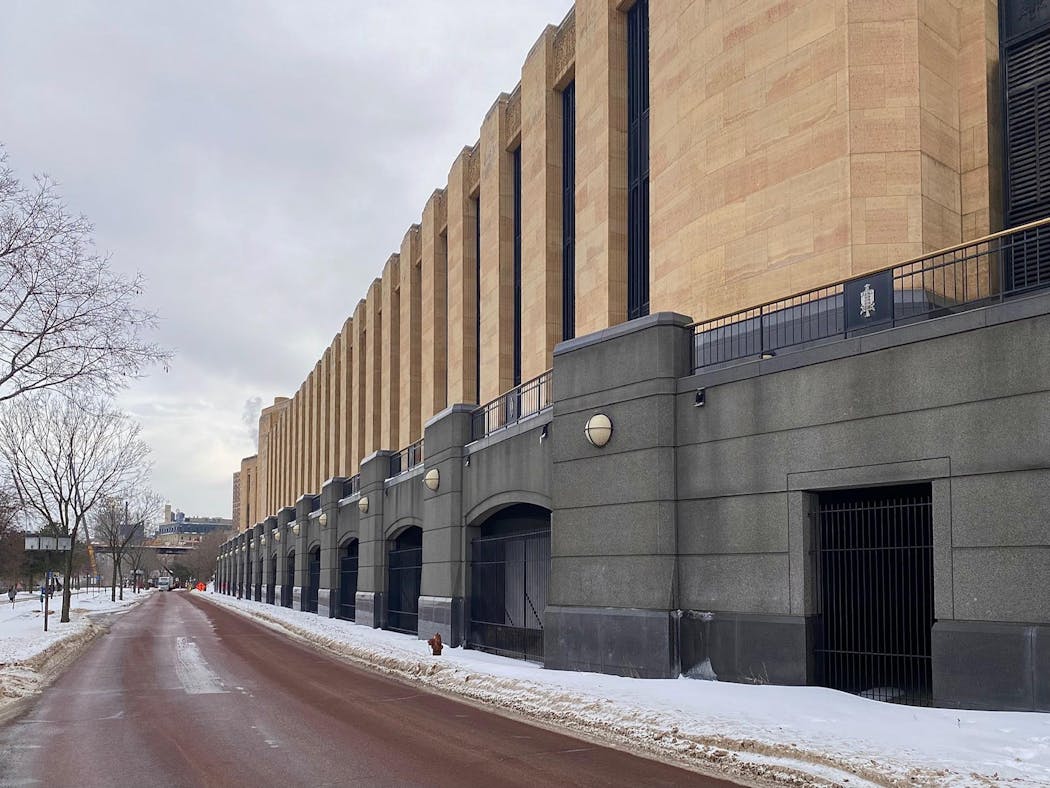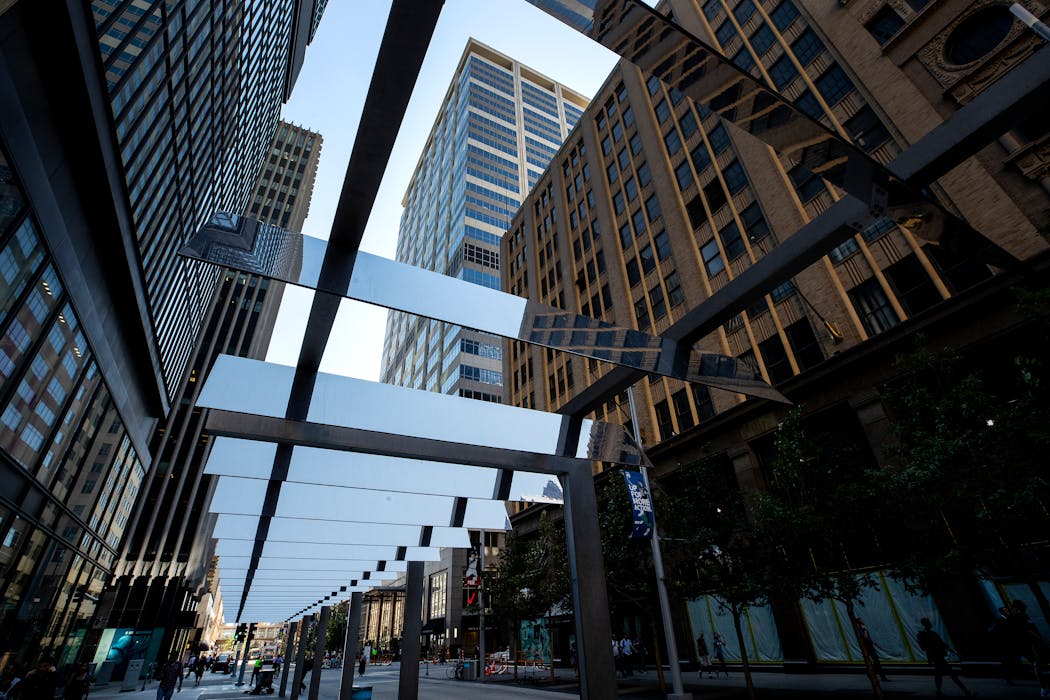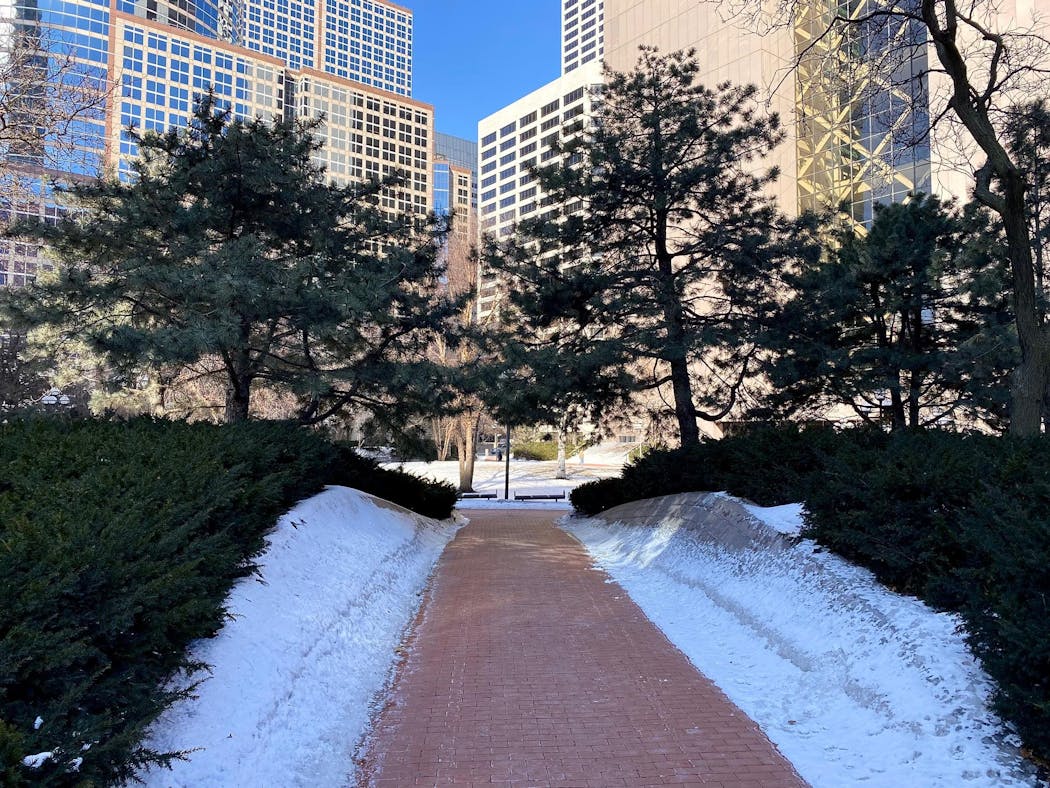Untapped opportunities abound on the Minneapolis streetscape. Tweaking outdated plazas. Boosting anemic riverfront amenities. Fixing poorly conceived freeway connections. The list could go on and on. Instead, here are seven suggestions for downtown improvements, plus one high-profile Chain of Lakes recommendation.
Postal promenade
Because the gigantic Minneapolis Post Office makes every effort to block downtown from the riverfront, you'd think that Postal Service leadership might consider a conciliatory gesture of civic-mindedness. For example: opening the long-closed second-story balcony that runs the length of the building's Mississippi River facade.
Well, think again.
"The terrace on the riverside of the building is closed to the public for security reasons," said Desai Abdul-Razzaaq of the Postal Service's corporate communications staff. "There are no future plans to open the terrace for public access."
Too bad, because the river views must be tremendous. Also locked and out of reach is a street-level loggia. Like the open-air promenade above it, the covered arcade was another designed-for-the-public amenity (home to a seasonal bike rental station, for example) that grew out of negotiations when the post office expanded on the prime riverfront site in the early 1990s. Yet there it sits, unused.
Field of dreams
Meanwhile, just to the north sits an empty lot, wedged between the Hennepin Avenue Bridge, the post office, its urbanity-killing parking ramp and West River Road.
It's where John H. Stevens built the first house in Minneapolis in 1849 (he later wrote how it would be surrounded by teepees that had materialized overnight), but you'd never know the site's significance today, given its forlorn state.
"It's one of the most fascinating pieces of real estate in town," said R.T. Rybak, former Minneapolis mayor and now president and chief executive officer of the Minneapolis Foundation. Postal Service obstinance and red tape are preventing the prime riverfront site from more active use.
Here's a big-picture thought: Demolish that ugly, underused parking ramp and create the long-awaited green link connecting Nicollet Mall, Gateway Park and the riverfront.
"Since the 1980s, this lot was intended to be a public space," said Rybak. "We should get our federal officials to help us get that land back into the public realm. There's just so much tremendous potential."
A bridge too much
Cities across the country— San Francisco, Seattle, Boston, Syracuse, N.Y. — are wisely replacing their intrusive elevated freeways. Minneapolis should do the same. Starting with the far-too-long I-94 entrance/exit ramps that brutally slice through the North Loop for more than a half-mile.
Sure, demolishing the current overpass and restoring the street grid would eliminate this grim concrete barrier, hurrah. But it would also return underused real estate back to one of the region's hottest neighborhoods. Development — and a subsequent boost to the property tax rolls — would surely follow. A much-needed park would be nice, too.
Enter and exit
Minneapolis does not excel at "Tah-dah" -style gateways. Witness Triangle Park, the small wedge-shaped green space that anchors a busy downtown exit from and entrance to I-35W. Dedicated volunteers work wonders to keep it a tidy, bloom-filled neighborhood respite.
But wouldn't it be great if MnDOT — which recently devoted $240 million and four years to overhaul 35W from downtown to Crosstown Hwy. 62 — made an effort to give the freeway's thousands of daily motorists some kind of a showy, memorable, ever-changing salutation along the park's edges: banks of lilacs in May, or peonies in June, or big bursts of asters in August? Or how about hanging thousands of lights in the park's grove of honey locust trees during their leafless winter slumber?
A poem as lovely as a tree
There are a number of reasons to refer to downtown's Main Street as Nicollet Meh following its recent $50 million remake, the work of James Corner Field Operations of New York City. One relatively easy correction would be pulling the plug on the "Light Walk," the gimmicky mirrored trellis that stretches between 6th and 8th streets. It's the firm's tepid replacement of a rejected earlier proposal (a dramatic glass staircase connecting skyway to pavement, a great idea that deserved further exploration) and it should have remained on the drawing board. You know what would be a huge improvement over this tacky toaster-oven-as-public-artwork? Trees. Trees are always an improvement. Especially on Concrete Street.
Untapped park potential
The Commons, that knockout of a park that spreads out in front of U.S. Bank Stadium, is missing a key element. In its original — and brilliant — design, the San Francisco-based landscape architecture firm Hargreaves Jones included a small cafe pavilion, knowing that food and drink would spark a continual draw to the two-block park. Budgetary constraints placed the building on hold, and the park's first six years have been cafe-free.
That's a shame, because look what happens when food trucks congregate on the Commons' 4th Street edge: people use — and enjoy — the park's well-landscaped grounds. Or look to the example that's set in other city parks, where a string of successful public-private partnerships have bestowed Minneapolis with such people magnets as Sea Salt Eatery in Minnehaha Park, Sandcastle at Lake Nokomis, Bread & Pickle at Lake Harriet, Mill Valley Market in Theodore Wirth Park and Owamni in Water Works Park.
Hemmed in
The Hennepin County Government Center's grassy, tree-lined south plaza is pretty to look at — especially from above, from the vantage point of nearby office towers — but at ground level the layout isn't particularly user-friendly. Part of the problem is that the plaza's perimeter is ringed by berms (part of the original — and aging — mid-1970s design) that act as visual and physical barriers to the surrounding sidewalks. Those berms also consume nearly a third of the plaza's footprint, and that square footage could be incorporated into much more active uses. Seed money for rethinking the two-acre park was included in the county's 2021 capital budget, but effort has since been tabled. Here's hoping the project moves forward, soon.
Lukewarm on the lake
The ice skating rinks that materialize each winter on the northern finger of Lake of the Isles constitute one of the Twin Cities' most picturesque cold-weather gathering places. Unfortunately, these dripping-in-romance surroundings are marred by a warming house in the form of a dreary trailer, a sterling example of Midwestern good-enough-is-good-enough practicality. A recently released draft of a long-range master plan for the park recognizes the current warming house's inadequacies and includes a new pavilion. How about staging a design competition for a structure that's worthy of this singular setting, and recruiting a corporate sponsor to foot the bill?

Want to share info with the Star Tribune? How to do it securely

A Minnesota field guide to snow shovels: Which one's best?
Sign up for Star Tribune newsletters










